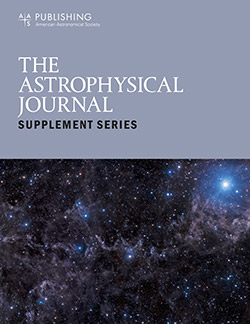Optical and Infrared Counterparts of the X-Ray Sources Detected in the Chandra Cygnus OB2 Legacy Survey
IF 8.6
1区 物理与天体物理
Q1 ASTRONOMY & ASTROPHYSICS
引用次数: 9
Abstract
Abstract The young massive OB association Cygnus OB2, in the Cygnus X complex, is the closest (∼1400 pc) star-forming region to the Sun hosting thousands of young low-mass stars and up to 1000 OB stars, among which are some of the most massive stars known in our Galaxy. This region holds great importance for several fields of modern astrophysics, such as the study of the physical properties of massive and young low-mass stars and the feedback provided by massive stars on star and planet formation processes. Cyg OB2 has been recently observed with Chandra/ACIS-I as part of the 1.08 Ms Chandra Cygnus OB2 Legacy Project. This survey detected 7924 X-ray sources in a square degree area centered on Cyg OB2. Since a proper classification and study of the observed X-ray sources also requires the analysis of their optical and infrared counterparts, we combined a large and deep set of optical and infrared catalogs available for this region with our new X-ray catalog. In this paper we describe the matching procedure and present the combined catalog containing 5703 sources. We also briefly discuss the nature of the X-ray sources with optical and infrared counterparts using their position in the color–magnitude and color–color diagrams.钱德拉天鹅座OB2遗留巡天中探测到的x射线源的光学和红外对应物
在天鹅座X复合体中,年轻的大质量OB星团天鹅座OB2是距离太阳最近的恒星形成区域(~ 1400 pc),拥有数千颗年轻的低质量恒星和多达1000颗OB恒星,其中一些是我们银河系中已知的质量最大的恒星。该区域对于现代天体物理学的几个领域具有重要意义,例如研究大质量恒星和年轻低质量恒星的物理性质以及大质量恒星对恒星和行星形成过程的反馈。天鹅座OB2最近被钱德拉/ acis - 1观测到,这是1.08 Ms钱德拉天鹅座OB2遗留项目的一部分。这次调查在Cyg OB2中心的一个平方度区域内发现了7924个x射线源。由于对观测到的x射线源进行适当的分类和研究也需要对其光学和红外对应物进行分析,因此我们将该地区可用的大量光学和红外目录与我们的新x射线目录结合起来。本文描述了匹配过程,并给出了包含5703个源的组合目录。我们还简要地讨论了x射线源与光学和红外对应物的性质,利用它们在色-星等图和色-色图中的位置。
本文章由计算机程序翻译,如有差异,请以英文原文为准。
求助全文
约1分钟内获得全文
求助全文
来源期刊

Astrophysical Journal Supplement Series
地学天文-天文与天体物理
CiteScore
14.50
自引率
5.70%
发文量
264
审稿时长
2 months
期刊介绍:
The Astrophysical Journal Supplement (ApJS) serves as an open-access journal that publishes significant articles featuring extensive data or calculations in the field of astrophysics. It also facilitates Special Issues, presenting thematically related papers simultaneously in a single volume.
 求助内容:
求助内容: 应助结果提醒方式:
应助结果提醒方式:


